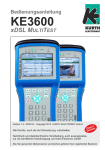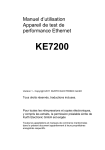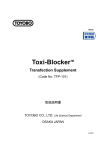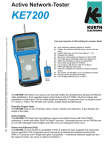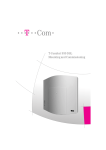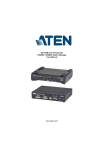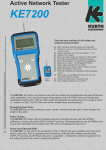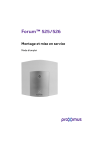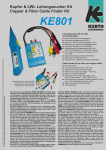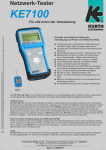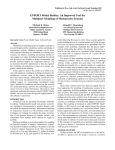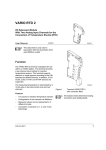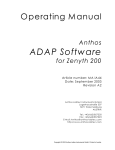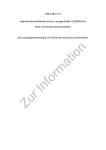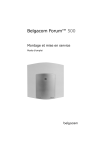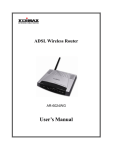Download KE3600-Operating Manual
Transcript
Operating Manual KE3600 xDSL MULTITEST Version 1.3 / 06/2014 - Copyright 2013 KURTH ELECTRONIC GmbH All rights reserved, including translations. All reprints and electronic copies, including excerpts, require prior written approval of Kurth Electronic GmbH. All of the brand names and trademarks cited herein are the property of their registered owners. ® Operating Manual KE3600 xDSL MULTITEST Keyboard / Display / Ports Ethernet 10/100 Management, Ethernet 10/100/1000 and optionale ISDN-Interface Fastener for shoulder strap Information LEDs KE3600 xDSL MULTITEST DSL CRC DSL LOSS DSL L1 BATT CHRG DSL L2 Speaker (telephony) Date / Time a/b: 0,0 V Battery charge Broadband 1 Interface <xDSL> <Annex A/M> 2 xDSL Mode 3 Terminal Mode Connection USB 1, SD-Card and optionale KECT3 module 4 Router Mode 5 Modem Mode ® Sunlight viewable color TFT Help F3 F2 F1 F4 SEL ESC Speaker monitoring (Telephone call) Menu-sensetive function keys F1 - F4 ESC (back) button Select (enter) button ON OFF 2 3 1 ABC DEF 4 GHI 5 JKL 6 MNO 7 8 Menu UP - DOWN / LEFT - RIGHT buttons ON/OFF button 9 PQRS TUV WXYZ * 0 # Microphone (telephony) Alphanumeric keypad xDSL Test Ports, Headset connection, Power supply connection KURTH ELECTRONIC www.kurthelectronic.de [email protected] 2 Operating Manual KE3600 xDSL MULTITEST Introduction With the KE3600 Multi Tester for xDSL, Ethernet, ISDN and GPON you have purchased a simple and intuitive solution for Line Qualifikation, Commissioning and Troubleshooting. In order to use the KE3600 often and successfully as possible, please read through this manual. The device was manufactured according to the following guidelines: 73/23/EEC DIN VDE 0800 DIN EN 61010 DIN EN 41003 DIN IEC 60068-2-1, 60068-2-2, 60068-2-3, 60068-2-14, 60068-2-27, 60068-2-6-fc, 60068-2-78, 60068-2-29 Should you have additional questions regarding the operation and use of this device, please contact: Kurth Electronic GmbH Mühleweg 11 72800 Eningen u.A. GERMANY Tel: +49-7121-9755-0 Fax: +49-7121-9755-56 E-mail: [email protected] www.kurthelectronic.de Safety Instructions Uhrzeit / Datum Showtime The KE3600 may only be operated with the accessories originally provided. Using the device with accessories that are not original or for applications for which it was not intended can lead to incorrect measurements and may damage the 4device. The relevant safety regulations in VDE 0100, 0800 and IPTV 0805 must be observed. Down n The use of connections other than those provided can damage the device. The device should not be used with high-voltage current. Kurth Electronic assumes no liability for damage resulting from improper use. n Never apply external voltage to the device. n Open the device only to change the batteries. See the instructions on page 17 . There are no other parts in the device that need to be serviced or calibrated. n The measuring device is protected from splashing water and dust by the front film covering. BIN However, it is not water-tight. n Never pull unnecessarily on the cables connected to the device. Uhrzeit / Datum Showtime KURTH ELECTRONIC www.kurthelectronic.de [email protected] 3 Operating Manual KE3600 xDSL MULTITEST Contents Keyboard / Display / Ports . . . . . . . . . . . . . . . . . . . . . . . . . . . . . . . . . . . . . . . . . . . . . . . . . . . . . . . . . . . . . Introduction . . . . . . . . . . . . . . . . . . . . . . . . . . . . . . . . . . . . . . . . . . . . . . . . . . . . . . . . . . . . . . . . . . . . . . . . Safety Instructions . . . . . . . . . . . . . . . . . . . . . . . . . . . . . . . . . . . . . . . . . . . . . . . . . . . . . . . . . . . . . . . . . . . Applications . . . . . . . . . . . . . . . . . . . . . . . . . . . . . . . . . . . . . . . . . . . . . . . . . . . . . . . . . . . . . . . . . . . . . . . . Preparation . . . . . . . . . . . . . . . . . . . . . . . . . . . . . . . . . . . . . . . . . . . . . . . . . . . . . . . . . . . . . . . . . . . . . . . . Keypad . . . . . . . . . . . . . . . . . . . . . . . . . . . . . . . . . . . . . . . . . . . . . . . . . . . . . . . . . . . . . . . . . . . . . . . . . . . . Informations LED's . . . . . . . . . . . . . . . . . . . . . . . . . . . . . . . . . . . . . . . . . . . . . . . . . . . . . . . . . . . . . . . . . . . Switching On . . . . . . . . . . . . . . . . . . . . . . . . . . . . . . . . . . . . . . . . . . . . . . . . . . . . . . . . . . . . . . . . . . . . . . . Connections . . . . . . . . . . . . . . . . . . . . . . . . . . . . . . . . . . . . . . . . . . . . . . . . . . . . . . . . . . . . . . . . . . . . . . . . Main Menu . . . . . . . . . . . . . . . . . . . . . . . . . . . . . . . . . . . . . . . . . . . . . . . . . . . . . . . . . . . . . . . . . . . . . . . . . Basic Information on Operation . . . . . . . . . . . . . . . . . . . . . . . . . . . . . . . . . . . . . . . . . . . . . . . . . . . . . . . . . Setup . . . . . . . . . . . . . . . . . . . . . . . . . . . . . . . . . . . . . . . . . . . . . . . . . . . . . . . . . . . . . . . . . . . . . . . . . . . . . Terminal Mode <xDSL> . . . . . . . . . . . . . . . . . . . . . . . . . . . . . . . . . . . . . . . . . . . . . . . . . . . . . . . . . . . . . . . Saving measurements . . . . . . . . . . . . . . . . . . . . . . . . . . . . . . . . . . . . . . . . . . . . . . . . . . . . . . . . . . . . . . . . QR Code . . . . . . . . . . . . . . . . . . . . . . . . . . . . . . . . . . . . . . . . . . . . . . . . . . . . . . . . . . . . . . . . . . . . . . . . . . Profiles . . . . . . . . . . . . . . . . . . . . . . . . . . . . . . . . . . . . . . . . . . . . . . . . . . . . . . . . . . . . . . . . . . . . . . . . . . . . Router Mode . . . . . . . . . . . . . . . . . . . . . . . . . . . . . . . . . . . . . . . . . . . . . . . . . . . . . . . . . . . . . . . . . . . . . . . . Modem Mode . . . . . . . . . . . . . . . . . . . . . . . . . . . . . . . . . . . . . . . . . . . . . . . . . . . . . . . . . . . . . . . . . . . . . . . Terminal Mode <Ethernet> / <SFP> . . . . . . . . . . . . . . . . . . . . . . . . . . . . . . . . . . . . . . . . . . . . . . . . . . . . . . Data Tests . . . . . . . . . . . . . . . . . . . . . . . . . . . . . . . . . . . . . . . . . . . . . . . . . . . . . . . . . . . . . . . . . . . . . . . . . Menu Structure . . . . . . . . . . . . . . . . . . . . . . . . . . . . . . . . . . . . . . . . . . . . . . . . . . . . . . . . . . . . . . . . . . . . . KE-Manager Software . . . . . . . . . . . . . . . . . . . . . . . . . . . . . . . . . . . . . . . . . . . . . . . . . . . . . . . . . . . . . . . . Changing the LiPo Battery . . . . . . . . . . . . . . . . . . . . . . . . . . . . . . . . . . . . . . . . . . . . . . . . . . . . . . . . . . . . . 2 3 3 5 6 6 7 7 8 9 9 10 11 12 12 12 13 13 13 14 16 19 20 ISDN- and Analog-Interface (optional) . . . . . . . . . . . . . . . . . . . . . . . . . . . . . . . . . . . . . . . . . . . . . . . . . . ISDN Testing . . . . . . . . . . . . . . . . . . . . . . . . . . . . . . . . . . . . . . . . . . . . . . . . . . . . . . . . . . . . . . . . . . . . . . . BERT Testing . . . . . . . . . . . . . . . . . . . . . . . . . . . . . . . . . . . . . . . . . . . . . . . . . . . . . . . . . . . . . . . . . . . . . . . Analog Testing . . . . . . . . . . . . . . . . . . . . . . . . . . . . . . . . . . . . . . . . . . . . . . . . . . . . . . . . . . . . . . . . . . . . . . 21 21 22 23 Copper Testing with KECT3 (optional) . . . . . . . . . . . . . . . . . . . . . . . . . . . . . . . . . . . . . . . . . . . . . . . . . Operation . . . . . . . . . . . . . . . . . . . . . . . . . . . . . . . . . . . . . . . . . . . . . . . . . . . . . . . . . . . . . . . . . . . . . . . . . . Connectors and Test Leads . . . . . . . . . . . . . . . . . . . . . . . . . . . . . . . . . . . . . . . . . . . . . . . . . . . . . . . . . . . . Operating . . . . . . . . . . . . . . . . . . . . . . . . . . . . . . . . . . . . . . . . . . . . . . . . . . . . . . . . . . . . . . . . . . . . . . . . . . Copper Parameters . . . . . . . . . . . . . . . . . . . . . . . . . . . . . . . . . . . . . . . . . . . . . . . . . . . . . . . . . . . . . . . . . . Digital Multimeter . . . . . . . . . . . . . . . . . . . . . . . . . . . . . . . . . . . . . . . . . . . . . . . . . . . . . . . . . . . . . . . . . . . . xDSL Line Qualification . . . . . . . . . . . . . . . . . . . . . . . . . . . . . . . . . . . . . . . . . . . . . . . . . . . . . . . . . . . . . . . KE900 Functions . . . . . . . . . . . . . . . . . . . . . . . . . . . . . . . . . . . . . . . . . . . . . . . . . . . . . . . . . . . . . . . . . . . . TDR - Time Domain Reflectometer (optional) . . . . . . . . . . . . . . . . . . . . . . . . . . . . . . . . . . . . . . . . . . . . 24 24 24 25 25 26 29 34 35 VoIP Tests (optional) . . . . . . . . . . . . . . . . . . . . . . . . . . . . . . . . . . . . . . . . . . . . . . . . . . . . . . . . . . . . . . . . 36 IPTV Tests (optional) . . . . . . . . . . . . . . . . . . . . . . . . . . . . . . . . . . . . . . . . . . . . . . . . . . . . . . . . . . . . . . . . 38 Glossary . . . . . . . . . . . . . . . . . . . . . . . . . . . . . . . . . . . . . . . . . . . . . . . . . . . . . . . . . . . . . . . . . . . . . . . . . . . 40 General Data . . . . . . . . . . . . . . . . . . . . . . . . . . . . . . . . . . . . . . . . . . . . . . . . . . . . . . . . . . . . . . . . . . . . . . . 46 KURTH ELECTRONIC www.kurthelectronic.de [email protected] 4 Operating Manual KE3600 xDSL MULTITEST Application The KE3600 is a fast, easy to use and affordable multitester for the installation and troubleshooting of DSL services in hybrid ADSL1/2/2 + / VDSL2 and combined networks. With its numerous interfaces, it supports the entire range of broadband network technology such as VDSL2-Vectoring, xDSL-Bonding, SHDSL, Gigabit Ethernet and GPON. Operation The KE3600 is a powerful troubleshooting tool for quickly finding faults in the network, outside wiring, customer devices or inside wiring. Even in hybrid networks where FTTH is installed, measurements can be made at any LAN connection using the Ethernet ports of the KE3600. For this reason, the KE3600 is the ideal solution for all broadband technologies. Use With its small size, robust design and intuitive operation, it is the perfect tester for installers and service technicians. The user can perform his tasks quickly and efficiently with automatic detection of the xDSL service and definable test procedures. The large display increases operating convenience and, when storing results, the technician has numerous options for exporting the tests and for compiling reports. Applications ADSL2+ ~10-20 Mb/s PON/PTB 100+ Mb/s PC PC VoIP TV VoIP STB xPON TV VDSL2 ~40 Mb/s ADSL2+ STB VDSL2 BONDING ~80 Mb/s VDSL2 ~40 Mb/s DSL Bonding CENTRAL OFFICE PC VoIP FTTN FTTB/ FTTC TV STB VDSL2 VDSL2 ~50 Mb/s PC VoIP STB VDSL2 VECTORING ~100 Mb/s xDSL MULTITEST DSL CRC TV KE3600 VDSL2 VECTORING ~100 Mb/s DSL LOSS DSL L1 BATT CHRG DSL L2 Date / Time a/b: 0,0 V Broadband 1 Interface <xDSL> <Annex A/M> 2 xDSL Mode 3 Terminal Mode 4 Router Mode 5 Modem Mode ® Fiber Help F3 F2 F1 F4 SEL ESC Copper ON OFF 1 4 GHI 7 KURTH ELECTRONIC www.kurthelectronic.de 2 ABC 5 JKL 8 3 DEF 6 Test xDSL MNO 9 PQRS TUV WXYZ * 0 # [email protected] Test Ethernet 5 Operating Manual KE3600 xDSL MULTITEST Documentation and Software Up-to-date operating instructions and software updates can be found in our KE3500 download area after logging on in the CUSTOMER LOGIN. You will find it under the Downloads menu item. After entering the serial number, you will find all current documents available for download in the following window. Setting up the KE3600 Battery charge display The KE3600 comes with a high-performance Lithium Polymer (LiPo) rechargeable battery. Despite its light weight, this allows the device to operate for up to 4 hours in measuring mode under a full load. The charger can simultaneously operate the KE3600 and charge the battery. The battery is safely charged by a special charge controller taking into account the time, voltage and current to ensure maximum service life. Note: Please fully charge battery before first use! Keypad When the KE3600 was developed, emphasis was placed on fast and easy operation. F1 – F4 Menu function buttons. F1: Help function if provided. ESC Similar to a computer, the ESC button means "undo the last step," or Back. SEL SELECT button. Use this button for selecting like an Enter key. ON / OFF Button for turning the device On and Off. Arrow buttons ▲▼◄► The arrow buttons are for menu scrolling UP ▲/ DOWN ▼and LEFT ◄ / RIGHT ►. Keypad Alphanumeric keypad with 1-0, A-Z, special characters. a/b: 0,0 V Text input Date / Time Showtime VTU-R (Annex B/J F1: abc " 123 Switch between letters and numbers input. Special characters can be found under the keys * and #. *: .-/@:_+,[];=? #: #$%&‛(){}~ F2: Delete the entire entry line with Clr F3: With Del delete individual digits F4: With ! deleting individual digits from right to left Line Values 1 Line Resync-Counter www.kurthelectronic.de 2 Data Filename 3 VoIP Dn/Near 4 IPTV p Up /Far 0 Actl 104973 50000 Kbps Max 134832 56034 Kbps Tx-Pwr 10.8 7.1 dBm Ø SNR-Margin 14.2 9.5 dB FEC 0 0 2 CRC abc " 123 KURTH ELECTRONIC 0:32:22 G993.2 VDSL2 (Vendor) Clr [email protected] 8 Del q ! 6 Operating Manual KE3600 xDSL MULTITEST Information LEDs The KE 3600 has five LEDs that display a range of important but easy-to-use information about the current status of the device. From left to right the LEDs mean: DSL CRC – orange This LED lights when a CRC (checksum error) near end or far end is recognized. These errors (fewer than 10) can arise after a connection has been established. In any case, check if the counter is still counting to determine if other causes (faults) exist. You can access the error counter menu in the respective test menu. DSL LOSS – orange After a connection is established in non-resync mode, a DSL loss event is displayed here and also signaled with an intermittent tone for 10 seconds. The tone can be stopped by pressing SEL once. DSL L1 – green When the KE3600 is activated in xDSL Mode, this LED begins to flash at 2 Hz to signal Ready Status. It is waiting for a carrier. As soon as this is detected LED flashes at 4 Hz until the connection is established, and then it is lit steadily as long as the connection exists. DSL L2 – green For DSL connection on Line 2 (bonding). BATT CHRG – green and red This display is active even when the KE3600 is turned off. The green LED indicates that the power supply or charger is inserted and is supplying power. The red LED signals that the battery is in charging mode. This produces a green/red or orange display during charging. Once controlled charging is complete, the red LED turns off and only the green LED lights to signal that the power supply or automatic charger is still active and that charging is complete.The power supply enables the KE3600 to be charged and operated SIMULTANEOUSLY. The car charger only charges the battery. Switching On The KE3600 works with an operating system that has to be booted. The boot menu with various device parameters such as the hardware and software versions appears at the end of the booting process. You can bring up the main menu immediately by pressing any button. KURTH ELECTRONIC Fernmeldetechnik Serial: Firmware: Modem: Options: xxxxxxxxxxxxxxxx 1.1-0 0000000 / 000 / 00 / 000 ADSL, VDSL, Annex J, Annex M ...... HW-ID: B00000000B0000000 www.kurthelectronic.de [email protected] 7 Operating Manual KE3600 xDSL MULTITEST Connections xDSL-TEST Ports The test port has one shielded RJ11 and one RJ45 port. This is the connection point for the test cables. However, a connection cable for a modem can also be inserted. Do not plug in a RJ11 plug into a RJ45 jack. This may damage the jack. Ethernet-Ports The Ethernet ports have different functions. He serves as a download port in conjunction with the KE-manager for the stored measurements, or to upload any software upgrades. In modem mode and router mode, it is the Ethernet port to the customer devices. USB Port Data may be loaded and software updates performed by way of this port. (Not yet activated) Connections for copper test (optional) For two two-conductor shielded measurement cables with device end, three-pin plug TF. ISDN interface (optional) ISDN and analogue connections RJ11 and RJ45. Slot for SFP modules Copper / Fiber Ports upper side USB 2 1000 Mb 1 GBit/s-Port for Ethernet-Tests 10/100/1000 MBit/s Device-Management-Port 10/100 MBit/s 100 Mb Yellow LED: Link / Data LED lights continuously: Connection has been established LED flashes: Transmit / receive activity Green LED: Transmission speed USB 2 ISDN Interface (optional) POTS ISDN-U ISDN-S SFP Slot for SFP modules Copper / Fiber for GPON- and Ethernet-Measurements ISDN/Analogue Test Ports RJ11 and RJ45 Side ports USB 1 B SD A GND GND GND GND A B USB 1 SD-Card e.g. for longterm measurements. Insert/remove SD-Card when the device is switched off! Connections KECT3 for copper testing (optional) RING TIP LINE 1 TIP LINE 2 RING Bottom ports xDSL Test Ports RJ11 and RJ45 USB 3 Headset connection xDSL Test Port USB 3 Power supply connection KURTH ELECTRONIC www.kurthelectronic.de [email protected] 8 Operating Manual KE3600 xDSL MULTITEST Main Menu Display Line voltage The battery display is at the top left. After calibration, it shows the actual battery charge using 16 levels. In the center, the line voltage is shown in xTU-R mode in the main menu with a precision of approximately +/- 5%. This tells you if there is any line voltage and its level so that you can distinguish between an analog and ISDN connection. This also reveals if the measurement is before or after a splitter. The date and time are shown to the right. Four selection positions are available in the main menu: 1. Broadband 2. Telephony 3. Copper Test 4. Setup a/b: 0,0 V Date / Time Main Menu 1 Broadband 2 Telephony 3 Copper Test 4 Setup Help General Operation In all the menus and submenus that have selection functions, the selectable parameters are either identified with left and right arrows (◄ and ►) or without arrows. When the entry is marked with the left and right arrows, you can switch between parameters by pressing the ◄ / ► buttons. When the entry is without the arrows, press SEL (SELECT) to move to a submenu where you can change settings. Press ESC to exit and save the selection in the menu. In the main menus, the previously selected menu item is saved. The next time you turn on the device, the scrollbar is automatically set to the previously selected item. Markings < < < < ? ! > disabled > activated, all inputs in order > activated, complement inputs > test possible > activated, correct entries > test not possible a/b: 0,0 V > test possible Date / Time VoIP Parameters 1 Authentication p 2 Password 3 Caller ID 4 Domain Red bar: Input / verification required! <Aus> 5 User Agent 6 UDP/RTP Port 7 UDP/RTP Port Range 8 Stun Server <5.060> <0> <Off> 9 Registrar <Off> 0 Proxy <Off> q Help KURTH ELECTRONIC www.kurthelectronic.de [email protected] 9 Operating Manual KE3600 xDSL MULTITEST Setup (Basic Device Settings) 1. Automatic Off Automatic shutoff after the last button is pushed. Possible settings: Always On / 3 minutes / 5 minutes / 15 minutes / 30 minutes / 60 minutes. When a test is running the KE3600 does not shut off even after the time has elapsed. 2. Backlight Possible settings: Always On / Always Off / 3 minutes. Lets you specify the duration before the screen is dimmed in order to preserve the battery. In the selection of 3 minutes additionally appears 3. Brightness Dimmed as another menu item. Possible values are from Level 1 to 7, where 1 is dark and 7 is light. 3. Language Menu languages: German, English, French, Spanish, Portuguese, Italian, Dutch. German is the default. 4. Date & Time Time and date setting: 12 or 24 hour format Format DD.MM.YY HH:MM e.g. 21.12.07 13:14 5. Software Updates Checks to see if an update is available and allows ist installation. Basically, the power supply must be plugged for safety during an update / upgrade, the LED for Batt Chrg must light up green or green and red (orange). Power loss during update / upgrade can have the consequence that the KE3600 stops working and needs to be returned to the manufacturer. The possible need new installation by faulty software can only be downloaded from the manufacturer for a fee. After a successful update / upgrade process for KE3600 is rebooted. The update or upgrade is only possible with the respective current matching KE-Manager. 6. Signals & Display You can find more settings: 1. Keybord Beep 2. LOSS Beep 3. Low Battery Beep 4. Brightness On or Off On or Off On or Off Level 1 to 7 (1 dark, 7 light) 7. Systeminformation Here you find information concerning Serial number, Firmware, Modem, installed Options and the HW-Id. a/b: 0,0 V Date / Time Versions Module UPD APP BCM Date / Time a/b: 0,0 V Systeminformation Systeminformation Licences Versions Licences KE000150 SW-Version 001.002.007 000.012.032 Module/Feature ADSL Annex J 18D6CF118414 001.406.030 Annex M Yes CU 001.007.000 ContSave Yes TDR 001.005.001 CopQual Yes 001.008.000 DslExpert Yes 004.018.001 Ethernet Yes 001.010.000 Hardware Yes HW-Version 002.000.241 UTI ISDN LPC 003.000.000 More KURTH ELECTRONIC Licence granted Yes Yes More www.kurthelectronic.de [email protected] 10 Operating Manual KE3600 xDSL MULTITEST 1. Interface a/b: 0,0 V Setting options:<xDSL>/<Ethernet>/<SFP>/<SHDSL>. The menu view changes depending on the selected interface. Date / Time Broadband 1 Interface <xDSL> <Annex A/M> 2 xDSL Mode 3 Terminal Mode 4 Router Mode 2. xDSL Mode 5 Modem Mode Setting options: <Annex A/M>/ <Annex B/J>. In Annex J, a second synchronization approach is needed because the filter from Annex B to Annex J has to be switched over. Help 3. Terminal (xDSL) with automatic detection of DSL Services Synchronization with 1 / or press START to run the test ... Duration of the synchronized connection Line Values Display a/b: 0,0 V Actl: Actual Up/Downstream Max: Maximum Up/Downstream Tx Pwr: Transmission power / dBm Ø SNR-Margin: Difference between line SNR and required SNR in dB FEC: Forward Error Correction CRC: Checksum error HEC: ATM-Header Error Check Bitswap: Redirected data of a disturbed communication channel to other channels Ø Line Atten.: Attenuation in dB INP: Impulse Noise Protection Interleave: Delay in ms or 0 for Fast-Path Line Loss: Loss of the synchronized connection LOF: ATM receiving station has lost the frame description LOM: Loss of Margin SES: Severely Errored Second: a second with bit error rate UAS: Number of seconds during which no transfer was possible ES: Errored Second: one second of measurement time during which one or more bit errors are present F1 More (select with SEL) n Help (reserved for help functions) n Resert errors (shown errors will be set to zero) n Save measurement or directly during the measurement by pressing the SEL key. It opens up a Window where the file name can be entered as a name / number. After confirming with SEL the measurement is stored on the internal memory, and can be edited using the supplied KE Manager software. KURTH ELECTRONIC www.kurthelectronic.de Showtime VTU-R (Annex B/J Line Values 1 Line 2 Data 3 VoIP IPTV 4 p Up /Far Dn/Near Resync-Counter 0 Actl 104973 50000 Kbps Max 134832 56034 Kbps Tx Pwr 10.8 7.1 dBm Ø SNR-Margin 14.2 9.5 dB FEC 0 0 CRC 2 8 HEC 0 More Views Help Reset errors Save measurement Line Values PPP Status Bands Vectoring SNR BAT Hlog QLN a/b: 0,0 V Function keys and options Date / Time 0:32:22 G993.2 VDSL2 (Vendor) 0 q Tests Ping Traceroute Http Download FTP Download FTP Upload VoIP Log VoIP Statistics VoIP Dial IPTV Log IPTV Statistics IPTV Preview Date / Time 0:32:22 G993.2 VDSL2 (Vendor) Showtime VTU-R (Annex B/J Line Values - Bands 1 Line 2 Data 3 VoIP 4 IPTV p Up /Far Dn/Near SNR Margin 0 N/A dB SNR Margin 1 14.3 10.8 dB SNR Margin 2 14.1 9.1 dB SNR Margin 3 14.2 N/A dB SNR Margin 4 N/A dB Line Attenuation 0 0 dB Line Attenuation 1 0.0 0.1 dB Line Attenuation 2 0.0 1.0 dB q More Views [email protected] Tests 11 Operating Manual KE3600 xDSL MULTITEST F2 Views (Line Values, Bands, Vectoring, ...) n Line Values (see page 11) n PPP Status n Bands (Displays individual bands for SNR Margin, Line Attenuation, Signal attenuation and TX Power, see page 11) n Vectoring (Vectoring status, VCE MAC address, possible errors) n SNR/BAT/Hlog/QLN: Graphs for Bits per tone, SNR per tone, Hlog and QLN can be called up here (Downstream blue, Upstream green) This information is helpful to detect sources of interference that affect the signal to noise ratio. By pressing the ◄►keys, the yellow pointer moves and displays below the graph the numeric value F3 Test n Data Tests, VoIP- and IPTV-Tests a/b: 0,0 V 0:32:22 Uhrzeit / Datum G993.2 VDSL2 (Vendor) Showtime VTU-R (Annex B/J Line Values - Vectoring 1 Line 2 Data 3 VoIP IPTV 4 p Up /Far Dn/Near Vectoring state: 1 VCE MAC Address: 0:19:8f:16:27:ce Total error samples Ethernet pkts sent: 0 Total error samples Ethernet pkts sent discarded: 0 Total error samples statuses sent: 0 Total error samples statuses sent discarded: 0 q Views More a/b: 0,0 V Tests 0:32:22 Date / Time G993.2 VDSL2 (Vendor) Showtime VTU-R (Annex B/J Bits per tone 54 27 Saving Measurements You can save the data during the measurement by pressing the SEL button. A window opens where you can enter the memory as a name or number. After confirmation with SEL, the measurement is stored in the internal memory. After entering and confirming by selecting the character, this measurement is saved with the name or number you entered. Very useful is a specification, for example with Customers name or telephone number. The limitation is given only by the internal memory (2 GB). However, you should ensure that the stored data is regularly downloaded and deleted. The deletion is easily possible with the supplied KE-Manager. 0 0 More a/b: 0,0 V 43 Bits 0:32:22 Date / Time Showtime VTU-R (Annex B/J Line Values Line Resync-Counter QR code generation 4.096 Tests Views G993.2 VDSL2 (Vendor) 1 When you press the "7" key a QR code is calculated from a portion of the displayed data. This is then displayed on the screen and can be read with appropriate readers. 2.730 1.365 Tone: 2047, 8,8277 MHz 2 Data Filename 3 VoIP Dn/Near 4 IPTV p Up /Far 0 Actl 104973 50000 Max 134832 56034 Kbps Tx Pwr 10.8 7.1 dBm Ø SNR-Margin 14.2 9.5 dB FEC 0 0 2 8 CRC HEC abc " 123 0 Clr Kbps 0 Del q ! Profiles All parameters can also be created in the profiles menu from the KE-Manager. The profiles are then called to load and save profiles using the menu item. The loaded data can always be revised as described previously or changed. The change is only until they leave the test is valid if it is not saved before. KURTH ELECTRONIC www.kurthelectronic.de [email protected] 12 Operating Manual KE3600 xDSL MULTITEST Router Mode a/b: 0,0 V Connection of the KE3600 to the xDSL port and to the PC. Replaces the modem and the router. See the Menu Structure for possible settings. In Ping mode, the KE3600, after the Ping test was successfully performed used as a router. This means that via the Ethernet interface, Internet access can be performed. Date / Time Router Mode 1 START... 2 Load and Save Profiles 3 Auto Re-Sync <Off> 4 xDSL Mode <Annex B/J> 5 Seamless rate adaption 6 ATM Type <Off> <AAL5> 7 VPI <0> 8 VCI <32> 9 PTM Priority 0 VLAN Tagging <Normal> <On> <0> VLAN ID Help Modem Mode (Bridge Modus) Connection of the KE3600 to the xDSL port and to the PC. Replaces the modem. See the Menu Structure for possible settings. This mode is intended as a replacement modem mode. The Ethernet interface is connected by smooth here (bridge or through mode), and is now the DSL port on the terminal. Now the KE3600 can be employed as a full modem, both ADSL and VDSL in mode can be employed. This makes it possible to draw conclusion errors. Save the measurement with SEL Exit with ESC. The Ethernet interface is transparently switched to have the modem functions. a/b: 0,0 V Date / Time Modem Mode 1 START... 2 Load and Save Profiles 3 Auto Re-Sync 4 xDSL Mode 5 Seamless rate adaption 6 ATM Type <Off> <Annex B/J> <Off> <AAL5> 7 VPI <0> 8 VCI <32> 9 PTM Priority <Normal> Help Terminal Mode <Ethernet>, <SFP> Connection to the Ethernet interface of a modem / router or a hub / switch. See the Menu Structure for possible settings for ping, trace route, HTTP download, FTP download and FTP upload Profile All parameters can also be created in the profiles of the KE Manager. The profiles are then invoked to load and save profiles using the menu item. The loaded data can always be revised or amended. The change is only until they leave the test is valid if not previously stored. KURTH ELECTRONIC www.kurthelectronic.de [email protected] 13 Operating Manual KE3600 xDSL MULTITEST Data Test (Description available soon) KURTH ELECTRONIC www.kurthelectronic.de [email protected] 14 Operating Manual KE3600 xDSL MULTITEST Data Test (Description available soon) KURTH ELECTRONIC www.kurthelectronic.de [email protected] 15 Operating Manual KE3600 xDSL MULTITEST Menu Structure Select Terminal: <Ethernet>, <SFP> 1 Interface 2 Ethernet Interface Main Menu 1 Autonegotiation Off 1 Broadband 10MBit/s 100MBit/s 2 Telephony* Off / On 2 Speed 3 Duplex Mode 10MBit/s/100MBit/s/1000MBit/s Off / On 3 Terminal Mode 3 Copper Test* 4 Setup * optional <xDSL> 1 Interface <Annex B/J> <Annex A/M> 2 xDSL Mode 3 Terminal Mode 4 Router Mode 5 Modem Mode Setup 1 Automatic Off Always On / 3 minutes ... 60 minutes 2 Backlight Always Off / Always On / 3 minutes 1 to 7 Brightness Dimmed 3 Language German / English / ... 4 Date & Time Input 5 Software Updates Update (only active when update available) 6 Signals & Display 1 Keyboard Beep Execution 7 Reset Management IF 2 LOSS Beep 3 Low Battery Beep 8 System Information 4 Brightness Off / On Off / On Off / On 1 to 7 Display device info see page 10 1 bis 7 Some of the interfaces and functions are shown in the menu structure but have no function because they are not contained in the service package chosen. KURTH ELECTRONIC www.kurthelectronic.de [email protected] 16 Operating Manual KE3600 xDSL MULTITEST Terminal Mode 1 Load Profile Selection 1 START... 2 Save Profile Input 2 Load and Save Profiles 3 Delete Profile Selection 3 Data < > 4 VoIP < > 5 IPTV < > 1 Service Configuration 6 VOD Yes / No IPTV Router Mode 1 Service Configuration 1 START... 1 Design Interface 2 Load and Save Profiles see on top 3 Auto Re-Sync Off / On VCI 4 xDSL Mode Annex A/M / Annex B/J VLAN ID 5 Seamless Rate Adaption Off / On 6 ATM Type AAL5 / AALOPKT / AALOCEIL 7 VPI 0 ... 255 8 VCI 32 ... 65.535 9 PTM Priority Normal / High / Both 0 VLAN Tagging On VLAN ID Yes VPI Encapsulation Off / On 0 ... 4.095 PPPoA / PPPoE / IPoA / IPoE Authentication Off / On Username... Input Password ... Input Das Erste HD BR Sd HD NDR HD SWR BW HD SWR RP HD WDR HD 3sat HD ARTE HD KIKA HD Modem Mode Yes / No Yes 2 ATM/PTM PTM / ATM 0 ... 255 32 ... 65.535 4 VCI 2 Load and Save Profiles see on top 5 VLAN Tagging 3 Auto Re-Sync Off / On 6 VLAN ID 4 xDSL Mode 6 ATM Type Annex A/M / Annex B/J Off / On AAL5 / AALOPKT / AALOCEIL 7 VPI 0 ... 255 8 VCI 32 ... 65.535 Normal / High / Both Off / On 0 VLAN Filter/Tagging On VLAN ID KURTH ELECTRONIC q 1 Eigenes Interface 3 VPI 1 START... 9 PTM Priority p Secondary Interface Secondary Interface 5 Seamless Rate Adaption On 2 IP Configurat. via DHCP 2 Select Profile Encapsulation On VLAN Tagging Yes / No 0 ... 255 32 ... 65.535 Off / On 0 ... 4.095 IPoA 7 Encapsulation On 0 ... 4.095 IPoE 8 IP Configuration via DHCP On 0 ... 4.095 www.kurthelectronic.de [email protected] 17 Operating Manual KE3600 xDSL MULTITEST Data 1 Auto Re-Sync 1 Dial-in a. Modem Conf. 3 Seamless Rate Adaption 2 BERT 4 ATM Type 3 Ping < > 4 Traceroute < > 5 HTTP Download < > 5 Encapsulation 6 VPI 6 FTP Download < > 7 FTP Upload < > 8 Update Download < > 0 ... 255 32 ... 65.535 Off / On 7 VCI 8 VLAN Tagging VLAN ID On 9 Authentication Username... On Password... VoIP 1 VoIP Parameters < 3 JitterThreshold 4 MOS Threshold 5 Session Expiration 6 Auto Accept Calls 7 Silence detection 8 Echo 1...960 ms 1...960 ms 0,0...5,0 0...6400 s Off / On Off / On Off / On VoIP Parameter 1 IP Address 1 Destination Address...* 56 ... 2.048 Bytes 3 Packet Number 0 ... 20 / unlimited 1 Destination Address...* 2 Number of Hops see above 1 ... 100 3 Timeout None / 0 ... 120 s 1 URL Input Input Input 2 Username... Input 3 Password... 2 Password Input Input Input 4 Several Downloads 4 Domain 5 User Agent 6 UDP/RTP Port 7 UDP/RTP Port Range 8 Stun Server On Stun Server 9 Registrar On Registrar 0 Proxy On Proxi Address 5 Number of Downloads Input 1...65.535 1...65.535 Off / On Input Off / On Input Off / On Input 2 Username... Parallel / Serial 1 ... unlimited 4 Simultaneous Downloads Input 0 ...10 1 Server... (Dest. Address...*) Input 2 Path Input 3 Filename Input SD-Card / Generated 1 MB ... 1 GB 3 Password... 4 Data Source Generated 5 Filesize 6 Password... 7 Simultaneous Uploads 1 URL 2 Username... 3 Password... www.kurthelectronic.de Input Input Input Input 1 URL 5 Username... KURTH ELECTRONIC 2 Hostname 2 Packet Length 1 Authentication 3 Caller ID 0 ... 4.095 Off / On Input Input Destination Address* > 2 Jitter Buffer Off / On Off / On AAL5 / AALOPKT / AALOCEIL PPPoA / PPPoE / IPoA / IPoE Input Input 0 ...10 Input Input Input [email protected] 18 Operating Manual KE3600 xDSL MULTITEST KE-Manager The KE-Manager is a flexible tool to manage the KE3600 and download the data of the measurements. The KE-Manager is like the KE3600 very clearly designed and largely intuitive and comes with the included CD-ROM (or Kurth Electronic Homepage). Setup of the PC When installing the KE-Manager, the user must have administrative rights and possibly turn off the virus protection and the Windows Firewall. Connection to the PC The KE3600 can be connected directly via the device management port to the Ethernet port of the PC. Optimally, however, is the use of an available Ethernet interface on the same network, so the PC can remain in the network. It will automatically determine an IP address (UPnP address) and the KE3600 appears with the IP address and serial number in the select list of the KE-Manager. Opening the KE-Manager Click on the KE-Manager icon on your PC desktop. The KE-Manager starts and displays by various colors on the connection status to the PC. If there are problems getting a connection to the device you can use the option Reset Management IF in the Setup menu. The green coloured background indicates the established connection.You are now ready to control KE3600 through the KE-Manager. Configuration Settings for several basic options and licensing, transmitter list (IPTV profiles) and the profil set can be executed here. x-DSL Gives close information to the active and stored tests. KURTH ELECTRONIC www.kurthelectronic.de [email protected] 19 Operating Manual KE3600 xDSL MULTITEST Loop Test Here you can consider the stored loop analysis tests from KECT3 Cooper Interface ISDN Here you can consider the ISDN tests Changing the LiPo Battery The decreasing battery charge is clearly identifiable on the display provided that the initial adjustment was done during first start-up. The battery can be charged, the charge control display red LED goes off, but the battery display still will not show full. As long as the displayed capacity does not go under 50%, the KE3500 can be safely used; it only has to be charged more frequently. If the display goes below 50%, you need to change the battery. You can either send in the device and the battery will be changed for a fee, or you can order a replacement battery. Changing the battery First remove the two lower compartment screws. Pull the bottom downward. The battery is in a plastic holder in the bottom part and it is plugged into the board with a plug protected against polarity reversal. After the housing is opened, this must be pulled out. Insert the new battery and securely fasten the holder. Plug the connection cable into the board and screw on the housing. Make sure to only hand-tighten the housing screws. KURTH ELECTRONIC www.kurthelectronic.de [email protected] 20 Operating Manual KE3600 xDSL MULTITEST ISDN and Analog Interface (optional) The KE3600, with its optional ISDN interface, provides all the functions needed for the installation and maintenance of S0, Uk0 and analog connections. It checks S0 interfaces in TE, NT and leased-line operation including Uk0 and analog interfaces. The handy tester provides voltage measurement and a bit error rate test (BERT) in addition to automatic connection, service and service feature tests. a/b: 0,0 V Date / Time Telephony 1 Interface <ISDN S0 TE> 2 Telephone 3 Self Call 4 BERT 5 Services 6 Monitor 7 Setup Under Interface, you can choose between the connection types of Analog, ISDN S0 TE, ISDN S0 NT and ISDN Uk0. Help ab: 0,0 V, S0: -0,0 V B1 Date / Time B2 Telephony S0 TE PMP (127) q XXXXXXXXXXX p Tx SA Tei C Frame P L1 TE 0 90 R RR NT 0 90 C I Telephone: ISDN S0 TE Enter a telephone number in the main field and press SEL to initiate a call. The ISDN or analog voltage is displayed at the top center of the screen. You get detailed information about the L1 status, TE and NT and you can set the volume from 1 (soft) to 7 (loud) using F4. Under F3 Ctrl., you can select the DTMF version A-D while F2 let you select the B-Channel and the different Services. With F1 More you can select Save trace to store the measurement for further use to the KE-Manager. Layer 1 activated 18 1 SETUP_ACK Help Activate L1 New TEI Save trace Clear phonebook Term B-Channel u Service u B-Channel Any 1 2 u None 100 W u Service Speech Data 3.1 kHz A 7 kHz A Video Packet Mode 56k RA ab: 0,0 V, S0: -0,0 V B1 q 100 W Options More SEL Date / Time Telephony S0 TE B2 PMP (127) q XXXXXXXXXXX Tx SA Tei C Frame P L1 TE 0 90 R RR NT 0 90 C I More p Layer 1 activated 18 1 SETUP_ACK Options Strg DTMF A DTMF B DTMF C DTMF D KURTH ELECTRONIC www.kurthelectronic.de [email protected] q 5 Volume Speaker on 1 ... 8 21 Operating Manual KE3600 xDSL MULTITEST Self Call Under the Self-call menu item (automated callback), you also get information on the L1, TE and NT status; you may select the time until the call is accepted using F3, and the service options using F2. BERT BERT (Bits Error Rate Test) implements a self-call. So that an incoming BERT connection can be accepted independent of a second serial interface and an AT interpreter, an independent process is running in the background. This process checks all incoming data connections to determine whether the called number (CdPN) corresponds to the set BERT MSN. If this is the case and if automatic BERT call acceptance is active, the process accepts the incoming call and outputs (depending on the verbosity setting) a BERT Connect message. Then, the incoming data stream is compared to the set test pattern. Differences are counted as bit errors. ab: 0,0 V, S0: -0,0 V B1 q XXXXXXXXXXX More 0 Pattern 100 W Term 0 1 29 0.153 210 215 0.151 220 0.151 220 0.153 223 0.151 None 100 W Date / Time B2 Self Call S0 TE q XXXXXXXXXXX Tx SA Tei C Frame P L1 TE NT 63 127 C UI Help Activate L1 New TEI Save trace Clear phonebook Layer 1 deactivated Frame with CRC error (... TEI CHECK REQUEST, T ... Register Call Speech Service More Speech Data 3.1 kHz A 7 kHz A Video Packet Mode 56k RA Date / Time Register Reject Immediately After 5s After 10s After 30s ab: 0,0 V, S0: -0,0 V B2 BERT ab: 0,0 V, S0: -0,0 V B1 B1 SEL Help Help Activate L1 New TEI Save trace Clear phonebook Date / Time B2 BERT State Period No Error With Errors Serious Error Total Errors Last min Last hour Last day Loss of Synchronization Send Bits Bit Error Rate SEL Synced 00:00:25 00:00:25 00:00:00 00:00:00 0 0 0 0 0 2048000 100,00 % 0,00 % 0,00 % 0 Stop +Error Generates an error Ends Measurement Exit the menu with ESC ab: 0,0 V, S0: -0,0 V B1 Date / Time B2 Services S0 TE Service Request Under the Service Request menu item, the important service features and whether they are supported by the dialed connection are clearly displayed. Language: Supports Unrestricted Digital Information: Supports Restricted Digital Information: not checked 3,1 kHz Audio: Supports 7,0 kHz Audio: not checked Video: not checked Packet Mode: not checked 56k Rate Adaption: Supports Help Help Clear phonebook KURTH ELECTRONIC www.kurthelectronic.de [email protected] 22 Operating Manual KE3600 xDSL MULTITEST Monitor (D-Channel Monitor) Display the D-Channel activities when establishing a connection, during the connection (3-way conference, forwarding, ...) and on connection release. The log can be saved to the internal storage. To do this, press F1 to select the Save trace option. a/b: 0,0 V Date / Time Setup (ISDN Telephony) Setup Telephony Under this menu item, you will find the basic setups for the telephony tests that are possible depending on the selected interface. 1 TEI <0>, <1>, <dynamic> <dynamic> Default MSN Any MSN 2 Outgoing MSN 3 Incoming MSN 4 Receive Ready Input Input <hide> 5 Termination <show>, <hide> <None>, <100 W> <0>, <1>, <29 0.153>, <211 0.152>, <215 0.151>, <220 0.151>, <220 0.153>, <223 0.151> <None> <0> 6 Pattern Help Analog Telephone Enter a telephone number in the main field and press SEL to initiate a call. The analog voltage is displayed at the top of the screen. F3 Monitor provides you with a high-impedance callmonitoring facility without affecting the interface.Using the headset, a conversation can be monitored without the KE3600 transmitting on this interface or affecting it in any way. Under F2 Dial Mode, either the DTMF or IWV dialing mode can be set. ab: 0,0 V, S0: -0,0 V a/b: 0,0 V Date / Time Telephony 1 Interface <Analog> 2 Telephone 3 Setup Date / Time Telephony analog a/b Help q XXXXXXXXXXX More DTMF Dial Mode Off Monitor SEL a/b: 0,0 V Date / Time Setup Telephony Help Clear phonebook DTMF IWF Off On 1 Dial Type 2 Pulse Length Setup (Telephony analog) Under this menu item, you will find the basic setups for the telephony test that are possible depending on the selected interface. <Pulse> <40ms/60ms> 3 Receive gain <-1 dB> 4 Transmit gain <33 dB> <Pulse>, <Tone> -6 dB ... 9 dB 30 ... 45 dB <Pulse>: 40ms/60ms, 33ms/66ms <Tone>: 82ms/82ms, 82ms/164ms Help KURTH ELECTRONIC www.kurthelectronic.de [email protected] 23 Operating Manual KE3600 xDSL MULTITEST Copper testing with KECT3 (optional) The KECT3 interface for copper testing is a simple and intuitive solution for troubleshooting and Copperprequalification. Operating The commercially available multiple xDSL systems (digital subscriber line system) have the task to offer fast data transfer for high-speed Internet access, for remote LAN access and interactive media applications, etc. The "x" in the name of xDSL signals the different types of DSL technologies, which use conventional copper cables for fast data transfer. xDSL modems use higher frequencies, and can therefore achieve a higher data transfer speed, even though they use the same wire pairs as for the analogue telephony (POTS) and ISDN.The main advantage of xDSL is the omission of the installation cost of new cable.The approved maximum line length and the maximum sustained data transfer rate depends on the characteristics of the cable. Before installing a xDSL modem should be checked whether the properties and quality of the selected pair of wires correspond to the demands of the chosen system. KECT3 – Functions a/b: 0,0 V n Troubleshooting with digital multimeter functions n Measuring all parameters required for qualification of the subscriber line from ADSL to VDSL2 n Automatic test programs provide detailed measurement results n Parameter editor to change the system and cable parameters n PC interface for data transfer to a PC n Fault location with optional TDR n Remote switch with optional Remote-Unit KE900 Date / Time Copper Test 1 Digital Multimeter 2 xDSL Line Qualification 3 TDR 4 KE900 Functions 5 Copper Parameters Help Connections and test leads Jack LINE1 (L1) This connector is the main connector. Jack LINE2 (L2) This connector is used for connecting the second pair of wires, e.g. for NEXT measurements, input only. Test leads For connection to the measured wire pair two two-wire shielded test leads are used. Both have on the device side a three-pin TF-plug with 4 mm in diameter and line sided tricolor banana plugs with 4 mm diameter with compression sleeves. The color coding of the banana plugs are: n Wire A red n Wire B green n Ground GND black The connection of the leads appended to the selected mode. When inserting the test leads, please make sure that the three-pin plug is inserted correctly. The 'B' lead is more widely spaced than 'A' or GND to prevent the plug from being inserted incorrectly. KURTH ELECTRONIC www.kurthelectronic.de B RING LINIE 1 A GND TIP GND GND LINIE 2 A GND TIP B RING only RX [email protected] 24 Operating Manual KE3600 xDSL MULTITEST Operating Starting & general rules Turn on the measuring instrument with the hardware module KECT3. On the opening screen the device name, the logo of the manufacturer Kurth Electronic, the firmware version, the UDMT version, the options installed, and the Hw-Id. are displayed. Shortly after the self-test the main menu appears. Before starting the measurements the user can make basic device settings in the setup. In most cases, the measurements and settings can be selected using the menudriven user interface. For selecting the vertical control buttons are used, then it is confirmed with the SEL button. Various cables and test parameters are selected by pressing the function keys F1 - F4. In order to facilitate and speed up the operation, some measuring modes can be selected directly using the function keys. To move to the previous screen, press the ESC key. The measurements begin immediately after selecting the parameters. Copper Parameters You can easily create new copper parameters as base for measurements within the menu item Copper Parameters. As default, the common cable Y_4x2x06 is deposited. Intended for the measurement, the cable satisfies other parameters, by the input of only two values, such as the cable diameter and the resistance per meter R, the remaining copper cable parameters are calculated from KECT3. Only the cable manufacturer specified VF-value needs to be entered. Press F4 Edit and jump with the left-right control keys through the values. The value is then selected with SEL and changed in the context menu on the numeric keypad. Make sure that the new settings are saved under a changed name as the default. Jump to Name and confirm with SEL - then opens the context menu to change the name - after changing the name go back to Line Parameters again with SEL and press F4 Save. The new name now appears under Cable Types in the selection menu. With SEL the desired value is selected, which then is marked with a hook at the right margin. a/b: 0,0 V Date / Time Copper Test 1 Digital Multimeter 2 xDSL Line Qualification 3 TDR 4 KE900 Functions 5 Copper Parameters Help a/b: 0,0 V Date / Time Copper Parameters 1 Y(ST)Y_4x2x06 2 Y(ST)Y_4x2x08 3 Y(ST)Y_4x2x04 4 Y(ST)Y_10x2x06 5 Help Edit Clear Date / Time a/b: 0,0 V Copper Parameters Name Y(ST)Y_4x2x06 Ø 0.600 mm R' 0.0636 W/m k 55.600 m/Wmm2 V 200.0 m/µs VF 0.66 a 0.0039 A C' www.kurthelectronic.de 0.098 V/2 100.0 T0 20 mm2 W/m nF/m m/µs °C K-1 Help KURTH ELECTRONIC 0.503 2R' 0.0716 [email protected] Save 25 Operating Manual KE3600 xDSL MULTITEST Digital Multimeter a/b: 0,0 V The large number of measurements allows a detailed error analysis and a complete overview of the electrical status of the line under test. Date / Time Digital Multimeter 1 Voltage 2 Capacitance 3 Capacitance balanced 4 Insulation 5 Loop Analysis 6 Resistance 7 Resistance line 8 Resistance line balanced Voltage 9 Current The purpose of this study is to measure the direct (DC) and alternating current (AC) external voltages that may be present on the cable. Measurement method Connect the wires to be measured and the shield of the cable. Select Voltage and press SEL. The measurement starts automatically thereafter. Up in the display the specification of the used copper parameter is shown. The results of AC and DC voltage are displayed in volts. Under F2 Probe you may select from differential voltage measurements between the two wires of a pair (A-B) and the common mode voltage, as measured between a pair of conductors and the ground (AGND, B-GND). Insulation Help a/b: 0,0 V DC Help Reset min/max Show min/max More 0,0 V A-B A-Gnd B-Gnd DC AC AC TP 100 W A-B Probe DC Area None Term In this setting KECT3 measures the insulation resistance between the two wires running a pair of wires and the individual wires and ground. Measurement method Connect the wires to be measured and the shield of the cable. Select Insulation and press SEL. The measurement starts automatically thereafter. Up in the display the specification of the used copper parameter is shown. The results are displayed in ohm. Under F2 Probe you may select from differential voltage measurements between the two wires of a pair (A-B) and the common mode insulation resistance, as measured between a pair of conductors and the ground (A-GND, B-GND). With F3 Test V, the test voltage can be changed from 100 V to 30 V. Date / Time Voltage a/b: 0,0 V None Date / Time Insulation < 1 MW Help Reset min/max Show min/max More A-B A-Gnd B-Gnd 100V 8V A-B Probe 100V TestV Resistance a/b: 0,0 V The purpose of this measurement is to determine the loop resistance. Off On Off Invert Date / Time Resistance Y(ST)Y_4x2x06 Measurement method Connect the wires to be measured and the shield of the cable. The far end of the measuring wire pair must be shorted, you have to work with a second Person or with the KE900 RemoteUnit. 0,810 W 4,915 m Off On More KURTH ELECTRONIC www.kurthelectronic.de A-B Probe [email protected] Off Invert 26 Operating Manual KE3600 xDSL MULTITEST Select Resistance and press SEL. The measurement starts automatically thereafter. Up in the display the specification of the used copper parameter is shown. The measured result is shown in ohms and the cable length calculated from the loop resistance is displayed in meters. Under F2 Probe the measuring points are chosen, such as two wires of a wire pair (A-B) and between a pair of conductors and the ground (A-GND, BGND). The Sense input is used for mismeasurements from the connection on a third wire (Murray method). Capacitance The purpose of measurement is to determine the operating capacity of a line. a/b: 0,0 V Date / Time Capacitance Y(ST)Y_4x2x06 Measurement method Connect the wires to be measured and the shield of the cable. The far end of the measuring wire pair must be open! Select Capacitance and press SEL. The measurement is started automatically thereafter. Up in the display the specification of the used copper parameter is shown. Capacitance is indicated and the cable length calculated from the capacitance is displayed in meters. Under F2 Probe the measuring points are selected, the two wires of a wire pair (A-B). 0,000 nF 4,915 m More Current a/b: 0,0 V Measurement method Connect the wires to be measured and the shield of the cable. Select Current and press SEL. The measurement starts automatically thereafter. Up in the dispaly the specification of the used copper parameter is shown. The results of the measurement of the AC and DC current is shown in Amperes. Under F2 Probe the measuring points are chosen, such as with two wires of a wire pair (A-B) and between a pair of conductors and the ground (A-GND, B-GND). www.kurthelectronic.de Date / Time Current KECT3 measures in this setting the direct (DC) and alternating current (AC).. KURTH ELECTRONIC A-B Probe DC 0,2 mA AC 1,4 mA More A-B Pulse [email protected] 27 Operating Manual KE3600 xDSL MULTITEST Loop Analysis The loop analysis permits automatic measuring sequences which can be selected by the user. Configuration The user configures the loop analysis by activating or deactivating entries in a table by pressing SEL that describes a given sequence containing all the measurements and options. 1. Command 'Port 1 connected to Port 2' to KE900 (if not activated, the instruction 'Connect CO' appears in the dialog window)* 2. Current measurement CO(A-B, A-GND, B-GND, AC & DC in each case) 3. Voltage measurement CO (A-B, A-GND, B-GND, AC & DC in each case) 4. Command 'All ports open' to KE900 (if not activated, the instruction 'Disconnect CO' appears in the dialog window)* 5. Current measurement (A-B, A-GND, B-GND, AC & DC in each case) 6. Voltage measurement (A-B, A-GND, B-GND AC & DC in each case) 7. Command 'Port 1 short-circuited' to KE900 (if not activated, the instruction 'Close loop' appears in the dialog window)* 8. Resistance measurement (only A-B) 9. Command 'All ports open' to KE900 (if not activated, the instruction 'Open loop' appears in the dialog window)* 10.Capacitance measurement (A-B, A-GND, B-GND) 11.Insulation resistance measurement (A-B, A-GND, B-GND) *If a command to the KE900 is not activated, a dialog window appears at the corresponding location with the described message and an associated tone (three short beeps) when the loop analysis is performed. Exit the dialog by pressing 'ESC' which reinitiates the measuring sequence, or you can press 'SEL' to manually trigger the unactivated command to the KE900. Measuring Procedure You can leave this page by pressing ESC which terminates the loop analysis. Press F2 (Load) to load a previously saved configuration, and press F3 (Save) to save the current configuration. Press F4 (Start) to start the loop analysis. When the loop analysis starts, the results page is displayed containing a results table of the measurements which are filled in as the loop analysis progresses. Dialog windows generated by the configured process may appear over the results table. These are confirmed by the user by pressing ESC or SEL. a/b: 0,0 V 1 Port 1+2 2 Current Voltage All Ports Open Current Voltage Port 1 shorted 8 Resistance 9 All Ports Open 0 Capacitance Insulation 3 4 5 6 7 Help www.kurthelectronic.de Load Save a/b: 0,0 V Start Date / Time Loop Analysis Result I= CO I~ CO U= CO U~ CO I= I~ U~ U~ Help A-B A-Gnd B-Gnd 0,0 mA 0,0 mA 0,0 mA 1,1 mA 0,9 mA 0,9 mA 0,000 V Close0,000 0,000 V Loop V 0,045 V 0,045 V 0,046 V 0,0 mA 0,0 mA SelmA (KE900) 0,0 Esc (Continue) 1,1 mA 0,9 mA 0,9 mA 0,000 V 0,000 V 0,000 V 0,045 V 0,045 V 0,045 V Conf. Start a/b: 0,0 V Save Date / Time Loop Analysis Result A-B I= CO I~ CO U= CO U~ CO I= I~ U~ U~ After the configured loop analysis is finished, you can restart it by pressing F3 (Start), or press F4 (Save) to open a dialog for saving the measurements for further processing in the KEManager. Press F2 (Conf.) to return to the configuration page. Press ESC to go from the results page to the Digital Multimeter menu. KURTH ELECTRONIC Date / Time Loop Analysis Configuration abc"123 A-Gnd 0,0 mA 0,0 mA 1,1 mA 0,9 mA 0,000 V 0,000 V SaveVResult0,045 V 0,045 0,0 mA 0,0 mA 1,1 mA 0,9 mA 0,000 V 0,000 V 0,045 V 0,045 V Clr [email protected] Del B-Gnd 0,0 mA 0,9 mA 0,000 V 0,046 V 0,0 mA 0,9 mA 0,000 V 0,045 V ! 28 Operating Manual KE3600 xDSL MULTITEST xDSL Line Qualification a/b: 0,0 V Measurements for physical prequalification of the copper pair for suitability to use xDSL services. Date / Time xDSL Line Qualification 1 Settings 2 Impedance Settings 3 Return Loss In Settings you can find predefined sets of parameters to be qualified for the DSL line. ADSL 1, 2 and 2 + or VDSL2 with different frequency ranges for the most common xDSL settings are stored. The manual entry also allows an individual value set. The start frequency and end frequency is defined and then stored. SEL selects the desired parameter.This is then marked with a hook at the right edge of the screen and is the basis for the following measurements for line qualification. 4 Balance No higher service setting (frequency) is required to perform the measurements! Disturbances in the highfrequency range have no influence on the low-frequency range. 5 NEXT Measurement 6 Receive Level 7 Transmit Signal 8 Spectrum 9 Wideband Noise 0 Impulse Noise Help a/b: 0,0 V Date / Time Settings 1 Band <ADSL2+> <15 kHz> <45 kHz> 2 Start Frequency 3 End Frequenz End Frequency Impedance 00.045.000 Hz n this mode, the line impedance can be measured. For example, if the input impedance of a device does not match the impedance of the line, there will be reflections, which reduces the power transmission and causes a resonance phenomena, and thus may lead to a non-linear frequency response. Measurement method Select the mode Impedance and press F3 SEL. The signal can be transmitted with different impedance values, these can be selected under F2 Impedance. Min, the lower value and with Max the upper value of the graphic are pre-defined. Measurement results The measurement results are available both graphically and numerically and are displayed simultaneously. Indicated is the frequency in Hz and the impedance in ohm. 5.000 .. 30.000.000 Hz Help a/b: 0,0 V Date / Time Impedance 800 W 649 496 5,00 kHz 8,33 kHz 11,7 kHz Help KURTH ELECTRONIC www.kurthelectronic.de [email protected] 15,0 kHz Impedance 80,0 kW Frequency 9,99 kHz auto Min auto Max 29 Operating Manual KE3600 xDSL MULTITEST Return Loss a/b: 0,0 V The line attenuation is the reduction of the energy of a signal transmitted over a transmission path and thus is a key value for DSL. The longer the cable, the lower the achievable data rates of DSL technologies. Measurement method Select the mode Attenuation and press SEL. The signal can be transmitted with different impedance values, these can be selected under F2 Impedance. Min, the lower value and with Max the upper value of the graphic are pre-defined. Measurement results The measurement results are both graphic and numeric available and are displayed simultaneously. Indicated is the frequency in Hz and the attenuation in dB. Transmit Signal will show you how to generate test signals for attenuation measurements. 59,6 dB 32,4 5,2 5,00 kHz 8,33 kHz 11,7 kHz Frequency 9,99 kHz Help 15,0 kHz Attenuation -0,27 dB auto Min 100 W Impedan. Balance Longitudinal currents can cause noise on the line, if the symmetry is imperfect.The line balance is the ability of the line to suppress the effect of longitudinal currents. The KECT3 performs the measurement with the help of the ITU-T recommended test circuit. Date / Time Return Loss auto Max a/b: 0,0 V Date / Time Balance 88,3 dB 75,6 Measurement method Select the mode Balance and press SEL. The signal can be transmitted with different impedance values, these can be selected under F2 Impedance. Min, the lower value and with Max the upper value of the graphic are pre-defined. 63,0 5,00 kHz 8,33 kHz 11,7 kHz Frequency 9,99 kHz Help auto Min 100 W Impedan. 15,0 kHz Balance 877 dB auto Max Measurement results The measurement results are available both graphically and numerically and are displayed simultaneously. Indicated is the frequency in Hz and the attenuation in dB. NEXT Measurement The transmission quality and thus the transmission capacity of a DSL system is strongly affected by the near-end crosstalk (NEXT). The KECT3 sends a known signal on Line 1 and measures the received signal on line 2. If the NEXT value is out of range, there may be a wire twist problem (split pairs). These can be located with the TDR. (See TDR measurements) a/b: 0,0 V NEXT Messung 133 dB 116 98,1 5,00 kHz 8,33 kHz Frequency 9,99 kHz Help KURTH ELECTRONIC www.kurthelectronic.de Date / Time Y(ST)Y_4x2x06 100 W Impedan. [email protected] 11,7 kHz auto Min 15,0 kHz Crosstalk 1,12 dB auto Max 30 Operating Manual KE3600 xDSL MULTITEST Measurement method Select the mode NEXT Measurement and press SEL. The signal can be transmitted with different impedance values, these can be selected under F2 Impedance. Min, the lower value and with Max the upper value of the graphic are predefined. Connect the primary pair only to line 1 (Tx). Connect the second pair to be tested on line 2 (Rx). Measurement results The measurement results are available both graphically and numerically and are displayed simultaneously. Indicated is the frequency in Hz and crosstalk in dB. Receive Level In this mode the KECT3 can be used as a selective level meter in conjunction with Transmit Signal. The measuring range is adjusted as described in Settings. Measurement method Select the mode Receive Level and press SEL. The signal can be transmitted with different impedance values, these can be selected under F2 Impedance. Min, the lower value and with Max the upper value of the graphic are pre-defined Measurement results The measurement results are available both graphically and numerically and are displayed simultaneously. Indicated is the frequency in Hz and the receive power in dBm. a/b: 0,0 V Receive Level Date / Time Y(ST)Y_4x2x06 133 dB 116 98,1 5,00 kHz 8,33 kHz Frequency 9,99 kHz Help 11,7 kHz 15,0 kHz Receive Power -106,3 dBm 100 W Impedan. auto Min auto Max Transmit Signal In this mode KECT3 generates signals for the Attenuation measurement. Further details of the Attenuation measurement, see in Attenuation. Settings Select the operating mode Transmit Signal and press SEL. Up in the display the specification of the used copper parameter is shown. The signal can be transmitted with different impedances, these are selectable under F2 Impedance. Under F3 Power, the transmission power can be increased in increments of 1 dBm or reduced. Under F4 Frequency the start frequency as a function of the selected DSL version (shown in section 3.1) can still be customized. KURTH ELECTRONIC www.kurthelectronic.de a/b: 0,0 V Date / Time Transmit Signal Frequency 250 kHz Transmitpower Help 100 W Impedan. [email protected] 0 dBm Power Frequen. 31 Operating Manual KE3600 xDSL MULTITEST Spectrum a/b: 0,0 V With the Spectrum analysis, it is possible to examine the spectral noise across the DSL frequency range. Measurement method Select the operating mode Spectrum and press SEL. In the following screen, the Start Frequency, End Frequency, Impedance and whether the Termination ”On” or ”Off” is set. Pressing the 1 key of the numeric keypad starts the measurement process. Under F1 Mode, the waveform between Peak (maximum), Mean (Average measurement) and Normal (Peak + Mean) can be switched. Min, the lower value and with Max the upper value of the graphic are pre-defined. Date / Time Spectrum 1 START ... 2 Start Frequency <25,0 kHz> 3 End Frequency <30,0 MHz> <100> <Aus> 4 Impedanc Start Frequency 5 Termination 00.025.000 Hz 5.000 .. 30.000.000 Hz Help a/b: 0,0 V Measurement result The measurement results are available both graphically and numerically and are displayed simultaneously. Given the frequency in Hz and the level in dBm or dBm / Hz, whichever was selected from F2 Unit. Date / Time Spectrum 0 dBm -115 25,00 kHz 8,33 kHz 11,7 kHz Frequency 240,6 kHz Mode 15,0 kHz Level -107,20 dBm Unit Min Max Wideband Noise The transmitted signal of the subscriber lines is disturbed by noise which reduces the data transmission capacity. Contributors to noise include balance faults, crosstalk and poor connections to the switched telephone lines. The noise level is shown as single value, in dBm. a/b: 0,0 V Date / Time Wideband Noise Y(ST)Y_4x2x06 -82,01 dBm Measurement method Select the mode Wideband Noise and press SEL. The signal can be transmitted with different impedance values, these can be selected with F2 Impedance. With F3 Filter the different DSL filters are adjustable. Measurement results The measurement result is displayed numerically in dBm. KURTH ELECTRONIC www.kurthelectronic.de Help 100 W Impedan. [email protected] ADSL Filter 32 Operating Manual KE3600 xDSL MULTITEST Impulse Noise a/b: 0,0 V Impulse Noise is a variable noise, that is caused by external electromagnetic sources near the DSL line Impulse Noise 1 START ... <253 mV> 2 Threshold Examples of impulse noise sources The switching on or off of a refrigerator motor or elevator motor (telephone lines are often deployed in the elevator shaft) or other power pulses near telephone lines. The noise pulse is a voltage whose value is at least 12 dB higher than the power level of the background noise. The KECT3 works as noise-pulse counter. A pulse is counted, when the voltage of the received pulse has exceeded the preset threshold value for more than 500 µs. Measurement method + result Select the mode Impulse Noise and press SEL. Set Threshold and Impedance. By pressing 1 key the numeric keypad the measurement process starts. Displayed is the threshold in Volt, the duration in seconds and the number of measured noise pulses. 3 Impedance <100> Help a/b: 0,0 V www.kurthelectronic.de Date / Time Impulse Noise Threshold 10,0 mV Runtime 0:00:07 Number 0 Help KURTH ELECTRONIC Date / Time [email protected] Clear 33 Operating Manual KE3600 xDSL MULTITEST KE900 Functions a/b: 0,0 V With the Coppertest-Interface you have the ability to control the optional KE900 Remote Unit. The use of the KE900 Remote Unit for the remote-controlled line measurement allows you to: n One-man testing, no assistance required n Used in areas such as underground distribution, cable shafts, etc. without communication access n Subscribers' line stay in service until testing starts and will be restored after n Remote controlled switching functions such as cut through, loop, ground and open n Measurement up to 30 MHz with the use of the device at the far end n Ideal for testing dual pairs in preparation for channel bonding Date / Time KE900 Functions 1 Trace Tone On/Select 2 Open Ports 1+4 3 Port 1 Loop 4 Port 1 Loop Pulse 3 sec 5 Connect Port 1+2 6 Connect Port 1+3 7 Connect Port 1+4 8 Port 1+4 Loop to Ground 9 Port 1+4 Loop 0 Port 4 Loop Pulse 3 sec Help Possible remote unit modes: Trace Tone On/Select The trace tone send from KE900 and the port can be changed. Open Ports 1+4 Opens Port 1 and stops tracing tone. Used for measurements like open circuit noise, capacitance, leakage resistance Port 1 Loop Port 1 pair shorted. Used to measure the loop resistance. Port 1 Loop Pulse 3 sec Port 1 loop pulse for 3 seconds. With it you can clearly detect the far end with a TDR even the loop is correct terminated on the CO side. Connect Port 1+2 Port 1 connected to Port 2. Used to restore the subscriber's line before and after testing. Connect Port 1+3 Port 1 connected to Port 3. A test set on Port 3 can then be used for end-to-end measurements like attenuation in conjunction with a additional signal transmitter on the far end. Connect Port 1+4 Port 1 connected with Port 4. Port 1+4 Loop to Ground Loop Port 1 and Port 4 and connected to ground e.g. for resistance symmetrical measurement. Port 1+4 Loop Port 1 and Port 4 loop. Port 4 Loop Pulse 3 sec Port 1 and Port 4 loop pulse for 3 seconds. With it you can clearly detect the far end with a TDR even the loop is correct terminated on the CO side. Connect Port 2+4 Port 4 connected to Port 2. With it you can switch e.g. the exchange line on another pair of wires. Connect Port 3+4 Port 4 connected to Port 3, Port 1 open. Connect Port 1+2 and 3+4 Port 1 connected to Port 2 and Port 3 connected to Port 4. This configuration alowes to measure two independent loops for influence to each other. KURTH ELECTRONIC www.kurthelectronic.de [email protected] 34 Operating Manual KE3600 xDSL MULTITEST TDR (Time Domain Reflectometer) optional TDR mode works on the pulse-echo method. A measuring pulse is transmitted through the cable. When the pulse reaches the end of the cable, or a fault of the cable, a certain part of the pulse energy is reflected back to the meter. It measures the time required for the return of the pulse along the cable, and shows disturbances in the reflection. From that time, the distance is determined and displayed as a reflection curve. The shown reflection curve displays all changes in impedance along the cable. The amplitude of a reflection is determined by the size of the impedance change. a/b: 0,0 V Date / Time TDR 1 START ... 2 Hide Dead Range 3 Send On Port <Off> <1> <Off> 4 Impulse Length autom. Help a/b: 0,0 V Finds cable faults such as short circuit, opens, bridge taps, bad splices, water penetration and other damage such as lightning strikes, crushed cable etc. which changes the impedance of the cable. The maximum cable length for testing telecommunication cables in this case is up to 50,000 feet, depending on the gauge. Measurement method Select the mode TDR and press SEL. In the following screen you can make settings and set the measuring port. Pressing the 1 key the numeric keypad starts the measurement process.The distance to the fault is displayed on the screen when the cursor is set to the beginning of the fault location reflected pulse. Under F2 Pulse, the duration of the probe pulse are set in ns. With Gain under F3, the pulse energy can be increased. Under F4 Y-Zoom, the illustrated reflection curve can be magnified up to 10 times. When transmitting on L1 and measured on L2, opens, ground fault, etc. can be accurately located (crosstalk). Date / Time TDR 0,0 m Help Y(ST)Y_4x2x06 48,3 m 12.5 ns Pulse 12.5 ns 25 ns 50 ns 100 ns 250 ns 500 ns 1000 ns 2500 ns 96,7 m 0 dB Gain 0 dB 10 dB 20 dB 30 dB 40 dB 50 dB 56 dB 145 m x1 Y-Zoom x1 x2 x3 x4 x5 x6 x7 x8 x9 x 10 Press the ◄ / ► buttons to move the yellow pointer and to detect the exact distance to the cable fault. KURTH ELECTRONIC www.kurthelectronic.de [email protected] 35 Operating Manual KE3600 xDSL MULTITEST VoIP (optional) Date / Time a/b: 0,0 V VoIP p 1 VoIP Parameter 2 3 4 5 6 7 8 Jitter Buffer Jitter Threshold MOS Threshold Session Expiration Auto Accept Calls Silence detection Echo <60 ms> <20 ms> <0,0> <1,80 ks> <Off> <Off> <Off> 1 ... 960 ms 1 ... 960 ms 0,0 ... 5,0 ms 0 ... 6400 s <Off>, <On> <Off>, <On> <Off>, <On> q Help Date / Time a/b: 0,0 V VoIP xxxxxxxxx 1 Authentication 2 3 4 5 6 7 8 9 0 Passwort Caller ID Domain User Agent UDP/RTP Port UDP/RTP Port Range Stun Server Registrar Proxy p xxxxxxxxx xxxxxxxxx tel.t-online.de Input Input Input Input <5.060> <0> <Off> <Off> <Off> 1 ... 65.353 1 ... 65.353 <Off>, <On> <Off>, <On> <Off>, <On> q Help a/b: 0,0 V Date / Time 0:32:22 G992.5 ADSL2+ AnnexJ EU-60 (Infineon) Showtime ATU-R (Annex B/J) VoIP (Log) 1 Line 2 Data 3 VoIP 4 IPTV Ping Traceroute Http Download FTP Download FTP Upload VoIP Log VoIP Statistics VoIP Dial IPTV Log IPTV Statistics IPTV Preview Description Waiting for Network Interface... Connecting to SIP server Connected to SIP server p q Views More a/b: 0,0 V Tests Date / Time 0:32:22 G992.5 ADSL2+ AnnexJ EU-60 (Infineon) Showtime ATU-R (Annex B/J) VoIP (Dial) 1 Line 2 Data 3 VoIP 4 IPTV p Description SEL XXXXXXXXXXX q abc " 123 KURTH ELECTRONIC Test & Measurement Clr www.kurthelectronic.de Del [email protected] 36 Operating Manual KE3600 xDSL MULTITEST VoIP (optional) a/b: 0,0 V Date / Time 0:32:22 G992.5 ADSL2+ AnnexJ EU-60 (Infineon) Showtime ATU-R (Annex B/J) VoIP (Log) 1 Line 2 Data 3 VoIP 4 Description RX TX Bit rate Packets Packet Loss Jitter Jitter min/max Delay Delay min/max R-Value MOS 704 1053 0 0 0/0 40 39/40 92.5 4.40 704 1055 0 2 2/3 IPTV p Kb/s packets packets µs µs ms ms q Views More Tests Volume End Call with a/b: 0,0 V ESC Date / Time 0:32:22 G992.5 ADSL2+ AnnexJ EU-60 (Infineon) Showtime ATU-R (Annex B/J) VoIP (Log) 1 Line 2 Data 3 VoIP 4 IPTV p Description Waiting for Network Interface... Connecting to SIP server Connected to SIP server Call sip:[email protected] Connecting with sip:[email protected] Conneced with sip:[email protected] Call with sip:[email protected] ended q Views More a/b: 0,0 V Tests 0:32:22 Date / Time G992.5 ADSL2+ AnnexJ EU-60 (Infineon) Showtime ATU-R (Annex B/J) VoIP (Log) 1 Line 2 Data 3 VoIP 4 IPTV p Description Answer Call? Waiting for Network Interface... From XXXXXXXXXX Connecting to SIP server to XXXXXXXX Connected to SIP server Incoming call from XXXXXXXXXXX Sel (Yes)to: XXXXXXXXXXXXxxxxx Esc (No) q More KURTH ELECTRONIC Test & Measurement Views www.kurthelectronic.de Tests [email protected] 37 Operating Manual KE3600 xDSL MULTITEST IPTV (optional) Load IPTV profiles to the device with the KEManager Date / Time a/b: 0,0 V IPTV p 1 Service Configuration 2 Select Profile p Das Erste HD BR Sd HD NDR HD SWR BW HD SWR RP HD WDR HD 3sat HD ARTE HD KIKA HD q q Help Date / Time a/b: 0,0 V Service Configuration <Yes> 1 Design Interface 2 3 4 5 6 7 VPI VCI VLAN Tagging VLAN ID Encapsulation IP Configuration via DHCP p <Yes>, <No> 0 ... 255 <0> <32> <On> <8> <IPoE> <On> 32 ... 65.535 <Off>, <On> 0 ... 4.095 q Help a/b: 0,0 V Date / Time 0:32:22 G992.5 ADSL2+ AnnexJ EU-60 (Infineon) Showtime ATU-R (Annex B/J) IPTV (Log) - Das Erste HD 1 Line 2 Data 3 VoIP 4 IPTV p Description Initializing Modem Initilized Modem Trying to play: Das Erste HD Initialize Player Playback gestartet q Views More a/b: 0,0 V Tests Date / Time 0:32:22 G992.5 ADSL2+ AnnexJ EU-60 (Infineon) Showtime ATU-R (Annex B/J) IPTV (Statistic) - Das Erste HD 1 Line 2 VoIP Data 3 78807 95 331 138 1628.8 packets packets µs ms Kb/s 4 Packets Packet Loss Jitter Delay Bitrate IPTV p Description q More KURTH ELECTRONIC Test & Measurement Views www.kurthelectronic.de Tests [email protected] 38 Operating Manual KE3600 xDSL MULTITEST IPTV (optional) KURTH ELECTRONIC Test & Measurement www.kurthelectronic.de [email protected] 39 Operating Manual KE3600 xDSL MULTITEST Glossary ATM Asynchronous Transfer Mode (ATM) is a data transmission technique where the data traffic, encoded in small packets termed cells or slots of a fixed length (53 bytes where 48 bytes are data and 5 bytes are the cell header), is sent via asynchronous time multiplexing. ATM Adaptation Layer (AAL):The task of the AAL is to adapt data from higher layers to the format of the payload data field of the ATM cell and to transmit control information to the other side. IP uses the ATM Adaption Layer 5 (AAL5). AAL5 adaptation mainly performs the segmenting and reassembling of IP packets that do not fit into the short payload data field. BERT Bit Error Rate Test: The measurement to determine the bit error rate on transmission paths is known as the BER test or BERT. It is usually performed using test bit patterns transmitted by a measuring device, received again following transmission, and then compared. Bridge In a computer network, a bridge connects two segments on the level of layer two (link layer) of the OSI model. A bridge can work on the sublayer MAC or the sublayer LLC. It is then termed a MAC bridge or LLC bridge. Another difference is the way of determining the route of data packets in a transparent bridge and source routing bridge. The bridge mode of a DSL modem is usually a transparent mode, i.e., it only provides the data at the ETH port or takes them and makes them available at the xDSL port. CRC The cyclic redundancy check (CRC is usually used) is a method for determining a check value for data to detect errors during transmission or storage. CHAP CHAP (PPP Challenge Handshake Authentication Protocol) is an authentication protocol that is used with PPP. It is formally specified in RFC 1994. In contrast to PAP, more value is placed on security when transmitting the passwords. DTMF The multiple frequency method is the conventional dialing technique used in analog telephony and is the method used today primarily in the telephone exchange technique for transmitting the telephone number to the telephone network or a telephone system. Another term for the multiple frequency method is DTMF (Dual-tone Multi-frequency). ES Errored Second: one second of measurement time during which one or more bit errors are present. Limit: less than 8% of the measurement time. FEC Forward Error Correction (FEC for short; Error Detection and Correction, EDAC for short, is also often used) is a technique used to reduce the error rate during the storage or transmission of digital data and represents an error correction method. If forward error correction is used in a transmission system, the sender redundantly encodes the data to be transmitted so that the receiver can identify and correct transmission errors without further requests of the sender. FTP The File Transfer Protocol (FTP) is a network protocol for transferring files over IP networks, specified in the RFC 959 of 1985. FTP is located in the application layer (layer 7) of the OSI layer model. It is used to transfer files from the server to the client (downloading), from the client to the server (uploading) or between two FTP servers under client control (File Exchange Protocol). In addition, using FTP, directories can be created and read or directories and files can be renamed or deleted. Separate connections are used for control and data transfer: An FTP session starts when the client establishes a TCP connection to the Control Port of the server (the standard port for this is Port 21). Commands are sent to the server using this connection. The server KURTH ELECTRONIC www.kurthelectronic.de [email protected] 40 Operating Manual KE3600 xDSL MULTITEST responds to every command with a status code, often with an appended explanatory text. However, most commands are only permitted after successful authentication. HEC Header Error Check is a checking method used in the Asynchronous Transfer Mode (ATM) transmission technique that determines whether an ATM cell was properly received. In this method, the header of the ATM cell contains a header error code (HEC) in the fifth and last byte and this code corresponds to a Frame Check Sequence (FCS). It handles errors in the cell header, but it chiefly checks if the cell boundaries were correctly identified in the received bit stream. During reception, the receiver continuously calculates the expected HEC byte and compares it with the byte that it receives. If the two values do not agree, it first corrects the cell header when it relays the cell. After a few sequential errors, the receiver assumes that it has lost synchronization and restarts synchronizing the receiver. This is why ATM is termed asynchronous. It allows a much greater deviation of the synchronization of network elements than possible with PDH. This solution in ATM targets the integration of data traffic that, in contrast to the telephone networks that are centrally clocked with high accuracy, may come from the completely unsynchronized sources of private users. Hop The Hop Count is the number of steps that a packet must take on the path from the source to the destination; the number of routers lying along this path is logically one less. The Hop Count can be determined, for example, using the Traceroute diagnostic tool. The Time to Live approach in which a counter variable in the data packet itself is decremented by one with each hop is based on hops. If the counter variable reaches a value of zero, the packet is discarded, thus not relayed any further and deleted. This prevents data packets from wandering forever throughout the network and wasting resources if circular routes are formed due to faulty routing. HTTP The Hypertext Transfer Protocol (HTTP) is a protocol for transferring data over a network. It is mainly used to load websites from the World Wide Web (WWW) into a web browser. HTTP is one of the application-layerestablished network models. The application layer is addressed by the application programs and, in the case of HTTP, this is usually a web browser. In the ISO/OSI layer model, the application layer corresponds to layers 5–7. IPoA (IP over ATM) IP over ATM (IPoA) or, more precisely, IP and ARP over ATM, is a transmission technique in which various protocols can be combined with one another. This is the IP protocol with the Address Resolution Protocol (ARP) transmitted via ATM. In this technique that is not standardized and is described in RFC 1577 from 1994, the communication partners must have an ATM address and an IP address. The ATM network serves as the transmission network between the communication partners. Logical IP Subnets (LISs) that behave just like IP subnets are built on the ATM network. The ARP protocol is used for converting IP addresses into ATM addresses. IPTV Internet Protocol Television (IPTV) generally identifies the Internet transmission path for television programs and films in contrast to classic radio, cable or satellite. IPTV is neither a standard nor a concept and is thus only a generic term that can be found in very many different forms. The different forms extend from simple IPTV, computers or cellular telephones all the way to special terminals where the user does not even notice that he is using the Internet because he operates a set-top box by way of the television set. Interleaving This is used when communicating between an (A)DSL modem and the exchange. It ensures a high level of data security even when there are line disturbances by transmitting data packets in an altered sequence in a "zipper" procedure. Noise is thereby recognized and eliminated by the exchange. The speed of data transmission is not influenced by the interleaving procedure per se, but unfortunately the PING is poorer which is disadvantageous for online games, IPTV and VOIP: Interleaving increases the response times by a factor of 2 since the path on which interleaving occurs is traversed twice. The higher the time factor, the more errors can occur. The smaller the time factor, the shorter the response times. Interleaving is not used in fastpath mode. KURTH ELECTRONIC www.kurthelectronic.de [email protected] 41 Operating Manual KE3600 xDSL MULTITEST Latency Latency is the time that a data packet in computer networks requires from the transmitter to the receiver. This arises from the runtime in the transmission medium and the processing time of active components (such as a switch, in contrast to passive components like a hub). The latency corresponds to approximately one-half of the round trip time (back and forth path) of a ping. LLC Logical Link Control is the name for a network protocol in telecommunications that was standardized as IEEE 802.2 by the Institute of Electrical and Electronics Engineers. It is a protocol whose main purpose is data security on the connection level and therefore belongs to layer 2 of the OSI module. Line Loss Loss of the synchronized connection LOF (loss of frame) Loss of Frame (LOF) is a signal indicating that an ATM receiving station has lost the frame description. This signal is used to monitor the performance of the physical layer in frame-oriented networks. Modem A DSL modem, known in technical terminology as an "NTBBA" (Network Termination Broad Band Access), is a device for transmitting data by way of a subscriber line using DSL technology. It forms the network termination for the DSL line at the subscriber and thus represents the matching piece to the DSLAM. ADSL: The technical term for an ADSL modem is an ADSL Transceiver Unit – Remote or ATU-R for short. NT The Network Termination (NT) in telecommunication describes the point at which access to a communication network is provided to a terminal. Noise Margin Noise margin is the difference between the current line SNR and the SNR that is required for a specific bit rate. Example: SNR 1 line= 45dB SNR 2 required = 39dB (for 8000 kbps for example) Noise margin = 6dB (SNR 1 - SNR 2 = noise margin) Since the SNR of the line is a fixed value apart from fluctuations and the minimum noise margin, in order to maintain the noise margin of 6 dB specified in the DSLAM, the transmitted data rate must change when there are changes in the line from disturbances, length or other factors. If a line that has a very high NM is tested, it means that a higher data rate is also possible. This is also displayed by the KE3400B under max. data rate. Ping Ping is a diagnostic tool used to check whether a specific host can be reached in an IP network. In addition to this, most implementations of this tool today specify the time between transmitting a packet to this host and the receipt of an immediately returned response packet (= packet round-trip time or RTT). KURTH ELECTRONIC www.kurthelectronic.de [email protected] 42 Operating Manual KE3600 xDSL MULTITEST Point-to-Point Protocol The Point-to-Point Protocol (PPP) is, in information technology, a network protocol for initiating a connection via switched lines. The protocol is based on HDLC and is the successor to SLIP as well as a series of proprietary protocols of this type. The PPP over Ethernet protocol (PPPoE) regulates the encapsulation of PPP packets inside Ethernet frames. PPPoE is used, for example, by Deutsche Telekom for Telekom DSL connections (and for Telekom Bitstream, T-DSL-Resale connections and T-DSL Business Symmetrisch based on SDSL); several (up to 10) PPPoE sessions to different Internet service providers can exist at the same time using these Telekom DSL connections (exception: VDSL-based services including ADSL2plus paths implemented by way of these DSLAMs) if these sessions can be terminated on DTAG-BBRASs (via OC, Gate or Z-ISP). PPP over ATMPPPATMPPP over ATM protocol (PPPoA) regulates the encapsulation of PPP packets inside ATM cells. PTM Data transmission method that divides the data into specific memory blocks that all possess information about their respective destinations. It allows the long-distance data transmission lines of several devices to be simultaneously used for data transmission. The packets are sent and relayed in a zipper method by the different transmitters. QLN Quiet line noise describes noise in the line audible primarily when no other noise is being transmitted. Router Routers are network devices that can route network packets between several computer networks. They are used most frequently for connection to the Internet, for the secure connection of several locations (Virtual Private Network) or for the direct connection of several local network segments with adaptation to different network protocols if necessary (Ethernet, DSL, PPPoE, ISDN, ATM, etc.). Routers make their relay decision based on information from the network layer 3 (this is usually the IP address) or higher. When doing this, many routers also translate between private and public IP addresses (Network Address Translation, Port Address Translation) or model firewall functions using a set of rules. Seamless Rate Adaption Seamless Rate Adaption, possible with ADSL2+, also makes it possible to adapt the transmission speed to the transmission quality of the cable connection in the case of an existing connection without losing synchronization (thus without disconnecting the DSL line). This function is not yet implemented at this time (2010) by German ADSL2+ providers to a large extent (with the exception of HanseNet, QSC and M-net DSLAMs). SES Severely Errored Second: a second with a bit error rate of ≥ 1 · 10−3. SNR (signal-to noise ratio) The signal-to-noise ratio is a measure of the technical quality of the desired signal (for example, voice or video) onto which a noise signal is superimposed. It is defined as the ratio of the average power of the desired signal to the average power of the noise signal. SIP The Session Initiation Protocol (SIP) is a network protocol for initiating, controlling and terminating a communication session between two or more users. The protocol is specified in RFC 3261, among others. In IP telephony, SIP is a frequently used protocol. KURTH ELECTRONIC www.kurthelectronic.de [email protected] 43 Operating Manual KE3600 xDSL MULTITEST TE Terminal Equipment, a designation for data terminal equipment that is often used. TEI The Terminal Endpoint Identifier (TEI) is an identifier in the ISDN signaling protocol DSS1 used to identify the terminals. Together with the Service Access Point Identifier (SAPI), the TEI forms a unique address for one specific terminal in the data link layer (layer 2) of the D channel. Timeout Designates the time period that must expire before a process is canceled with an error. Time limitations make most sense to avoid situations where a process is waiting for something that either never occurs or only occurs after a very long delay. With regard to process synchronization, a timeout is that period of time for which a process should wait for the occurrence of a condition before an error is tripped. Especially with regard to computer networks, timeouts identify the time for which a process waits for a response before a data packet is considered lost and must either be transmitted again (retry) or communication is canceled with a (timeout) error. Traceroute Traceroute transmits multiple IP data packets to the destination host starting with a Time-to-live (TTL) of 1. The first router to relay the data packet decrements the value of the TTL by one to 0. It does not relay the packet but rather discards it because of this value. In this case, it transmits the ICMP response type 11: Time exceeded with a code of 0: Time to live exceeded in transit back to the source. This data packet contains the IP address of the router involved as its source address. This information is recorded by the Traceroute program together with the total round-trip time. After this, the program repeats this step with a TTL incremented by 1 to determine the next router in the path through the network. This process is repeated until either the destination host or the maximum number of hops used by the Traceroute program has been reached. The sequence of addresses collected in this way identifies the path through the network to the destination. The return path is usually identical but may differ in the case of asymmetrical routing. As a rule, three packets are sent to each host. The Traceroute result does not always show the actual path. It is affected by firewalls, incorrect implementations of the IP stack, network address translation, IP tunnels or by the selection of a different path in the case of a network overload, and other factors. URL A Uniform Resource Locator (URL) identifies and localizes a resource such as a website by way of the access method to be used (for example, the network protocol used such as HTTP or FTP) and the location of the resource in computer networks. The current version is published as RFC 1738. The RFC specifications are the industrial standards of the Internet Foundation IETF. URLs are a subtype of the general identification designation using Uniform Resource Identifiers (URIs). As URLs represent the first and most frequent type of URIs, the concepts are frequently used synonymously. In common usage, URLs are also known as Internet addresses or web addresses, which usually (with the Internet and WWW being frequently identical idiomatically) means the special URLs of websites. UAS Number of seconds during which no transfer was possible. VLAN A Virtual Local Area Network (VLAN) is a logical subnet within a switch or an entire physical network. It may extend over one or more switches. A VLAN separates physical networks into subnets by ensuring that VLANcompatible switches do not relay the frames (data packets) of one VLAN into another VLAN and this even though the subnets can be connected to common switches. Tagged VLANs involve networks that use network packets bearing additional VLAN identification marks. Tagging in VLANs is also used if the VLANs extend, for example, over several switches, say, via trunk ports. In this case, the frames bear an identification mark that indicates association with the appropriate VLAN. KURTH ELECTRONIC www.kurthelectronic.de [email protected] 44 Operating Manual KE3600 xDSL MULTITEST VOD Video-on-demand describes the possibility of downloading digital video material from an Internet provider or service upon demand or to view the material directly by way of a video stream using suitable software. For the video stream, reception in real time, a high-speed broadband Internet service via cable or DSL (at least 6000 kb per second for optimal video quality) is necessary. An Internet rate with unlimited data (data flat rate) is an advantage because this creates a large amount of data traffic. VoIP IP Telephony (short for Internet Protocol telephony) also known as Internet Telephony or Voice over IP (VoIP for short) is telephoning over computer networks built according to Internet standards. In this respect, information typical for telephoning, that is, voice and control information, for example for initiating the connection, is transferred by way of a network also useful for data transmission. Computers, telephone terminals specialized for IP telephony and classic telephones connected by way of special adapters can initiate the connection between the call participants. VPI/VCI ATM is based on connections that may either be permanent or only switched for a specific time by means of ISDN-like signaling. Virtual Paths (VPs) and Virtual Channels (VCs) are defined for this purpose. The header of each ATM cell contains a Virtual Path Identifier (VPI, 8 or 12 bits) and a Virtual Channel Identifier (VCI, 16 bits). As these cells pass through the ATM network, switching is achieved by changing the VPI/VCI values. Although the VPI/VCI values do not necessarily remain the same from one end of the line to the other, this corresponds to the concept of a line because all packets with the same VPI/VCI values take the same path. This is in contrast to IP where one packet might reach its destination using a different route than the preceding and following packets. Virtual lines have the advantage that they can be used as a multiplexing layer for different services (voice, Frame Relay, IP, SNA, etc.) that can then divide one common ATM connection without causing mutual interference. KURTH ELECTRONIC www.kurthelectronic.de [email protected] 45 Operating Manual KE3600 xDSL MULTITEST General Data Graphic TFT Display Languages 240 (RGB) x 320 German, English, Dutch, Spanish, Italian, Portuguese, French Test Port LAN Port GbE Port Power supply Capacity Low batt indication Power supply RJ11 + RJ45 RJ45 Device Management RJ45 Built in LiPo battery > 4 hours in Test Mode Coloumb counter 100 - 230 V AC 50/60 Hz Unit comes with AC power supply and charger, test leads RJ11-RJ45, RJ11 banana plug with rubber insulated crocodile clips, Ethernet cable, rugged cordura bag with additional space, Windows software for download of results and upgrade of unit. Dimensions Size Weight Housing Display protection 230 x 114/90 x 70 mm 9" x 4.5/3.5" x 2.8" 850 g (28 oz.) High impact resistant ABS, with drop protection 2 mm Plexiglass Environmental conditions Working temperature Storage temperature Humidity: -10 - +70°C -20 - +70°C up to 93%, non-condensing KURTH ELECTRONIC www.kurthelectronic.de [email protected] 46















































